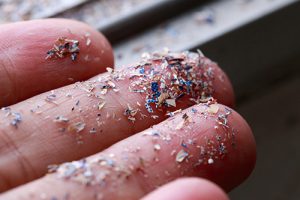Interpreting the extent and characteristics of microplastics pollution in Maine freshwater streams to guide a holistic mitigation strategy

Location: University of Maine
Sponsor: Maine Water Resources Research Institute 2022 (104b)
Widespread occurrence of miniscule plastic fragments (i.e., microplastics) in natural waters around the world is an imminent threat to ecosystem and public health. In Maine, microplastic pollution is especially concerning because the state is one of the largest producers of fish and shellfish in the nation and seafood consumption could contribute to microplastic ingestion. The pollution of Maine waters could also be detrimental to the abundance of sensitive ecosystems influenced by freshwater flows, eventually impacting the state’s coastal economy. In addition, the sources and the perception of risks associated with microplastics is not uniform across communities in the region. Many citizens remain unaware of the potential threats caused by microplastics in the food chain and drinking water sources, elevating the demand for information related to the presence and implications of microplastic pollution.
This project responds to these concerns and demands by focusing on microplastics carried in freshwater stream flows. Drawing on a transdisciplinary team approach, this study will: 1) detect microplastic pollution and describe the pollutant characteristics (e.g., particle dimensions, composition, mobility, concentration) in rural and urban freshwater streams in Maine; 2) interpret the sample collection and analysis outcomes (e.g., origins, chemical composition); and 3) communicate outcomes in a three-phase stakeholder engagement process to frame action-oriented mitigation options. The overarching vision of the project is to develop foundational knowledge for the detection, interpretation, and communication of microplastic pollution problems in Maine’s freshwater streams.
There are many sources of microplastics in freshwater streams, including wastewater treatment plant effluents, surface runoff after rainfall events (e.g., tire chips, artificial turf, other plastic debris), and direct input from human activities (e.g., navigation, fishing, recreation, littering). The team’s preliminary efforts revealed the presence of microplastics in more than 70% of collected water samples in Maine. This outcome aligns with published work from different regions of the world. Our approach is to perform a systematic sampling campaign to capture a range of watershed, hydrologic, and seasonal conditions. The description of the problem will focus on the conditions in which microplastic pollution problems are detected and the types of pollutants that are present. The project will leverage existing measurement infrastructure managed by team members and the USGS at pre-established monitoring stations (Smith), geospatial surface coverage data organized by team members in the region (Smith), ongoing harmful algal bloom sampling infrastructure (Ross) and federally funded microplastic analysis lab facilities (Apul). The project will also optimize use of a stakeholder guided risk assessment framework under development for other emerging pollutants in collaboration with Maine Department of Environmental Protection (Noblet). This capacity will be combined with expansion into additional locations and communities to capture conditions representative of the region (Zollitsch).
Project Update
Global plastic production has been increasing over the past 50 years and is causing an increase in plastic waste entering the oceans. Plastic in the ocean is broken down into microplastics by a variety of physical, chemical, and biological processes. They can occur in different shapes, including fragments, fibers, beads, and films. This study investigates the extent of microplastic fiber pollution in Frenchman Bay, Maine, and aims to characterize the fibers to determine potential source locations. Frenchman Bay is an important location in Maine’s economy because of its impact on tourism and commercial fishing. It also has some freshwater input, which makes it an ideal location to study the connection between microplastics on land and in the ocean.
Water samples were collected from a variety of river, estuary, and bay locations every week for two summers. An average of 2 fibers/L were found at all sampling locations, suggesting there are an estimated 400 billion microplastic fibers in the upper one meter of Frenchman Bay. In a complimentary sampling campaign, samples were collected from land-based locations such as a wastewater treatment plant, stormwater culverts, and various rivers on Mount Desert Island, which borders Frenchman Bay. The highest microplastic concentration was found in a storm drain, releasing an average of 15.3 fibers/L directly into Frenchman Bay. It is suspected that the microplastic fibers enter Frenchman Bay from land-based sources, as it was found that the size of the microplastics decrease as the sampling location becomes farther from land, and it appears the color fades in relation to distance from land as well. This study was able to quantify the microplastic fiber pollution in Frenchman Bay and characterize the microplastics to determine that they likely originate from local land-based sources for the first time.
About the Team
Team Leader:
- Onur Apul, Assistant Professor, Civil & Environmental Engineering, University of Maine
Team Members:
- Lauren Ross, Assistant Professor, Civil & Environmental Engineering, University of Maine
- Sean Smith, Associate Professor, Earth & Climate Sciences, University of Maine
- Brenda Zollitsch, Bangor Area Stormwater Group
- Caroline Noblet, Associate Professor, Economics, University of Maine
